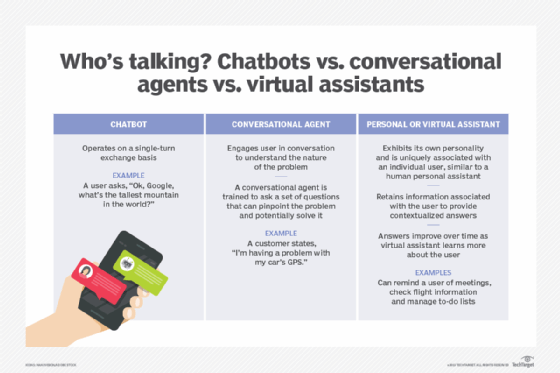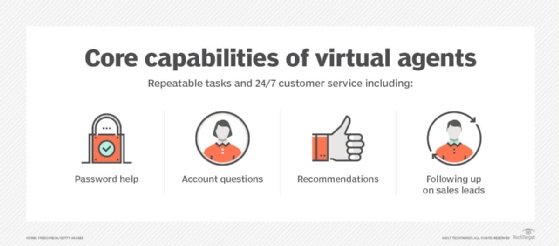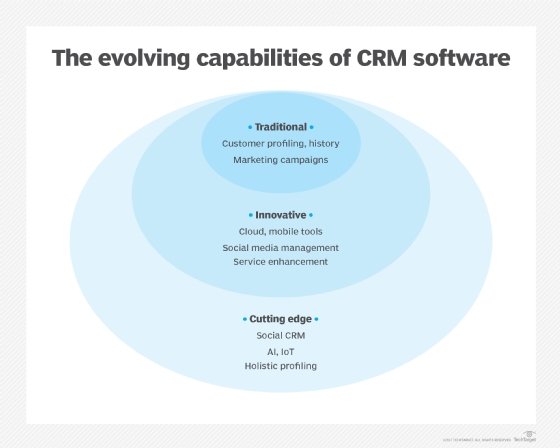
What are virtual agents and how are they being used?
What is a virtual agent?
A virtual agent -- sometimes called an intelligent virtual agent (IVA) -- is a software program or cloud service that uses artificial intelligence (AI) technologies, such as machine learning (ML) and natural language processing (NLP) to provide automated services or guidance to humans.
Many organizations now use virtual agents to augment their customer service operations. Virtual agents can answer routine customer queries, fulfill standard requests and handle simple problems. Organizations often deploy virtual agents to handle initial customer interactions in their call centers or on their websites. Virtual agents help to facilitate customer self-service capabilities and provide immediate access to relevant information. Difficult customer questions or concerns are typically escalated to human representatives.
Some organizations use virtual agents internally to support their personnel in different ways. For instance, IT departments might implement virtual agents to provide basic help desk services, such as answering simple technical questions or resetting computer passwords. Organizations might also use virtual agents to guide personnel through work tasks and processes.
In some ways, virtual agents are similar to digital assistants (also called virtual assistants). Digital assistants are programs that understand NLP voice commands and can answer questions, fulfill people's needs or help them complete tasks.
This article is part of
Ultimate guide to RPA (robotic process automation)
Technology research and advisory firm Gartner predicted that, by 2025, 37% of customers will try to use a virtual assistant to interact with a customer service department. Gartner has also predicted that, by that same year, half of all knowledge workers will use a virtual assistant daily, an increase from 2% in 2019.
What is the difference between a virtual agent and a chatbot?
The terms virtual agent and chatbot are sometimes used interchangeably. At other times, a chatbot is considered a specific type of virtual agent -- a conversational agent -- that can chat via email, messaging or voice. In fact, there is no universally agreed-upon definition for either term, although many people in the industry generally distinguish between the two.

The confusion between chatbots and virtual agents can be attributed, at least in part, to the fact that they have several characteristics in common. If a user goes to a website that presents an interactive window for accessing services, there is nothing to indicate whether the tool is a chatbot or virtual agent. Both types are available all day every day, provide relevant information as needed and can automate simple operations.
Under the right circumstances, either one can help improve the customer experience by offering efficient self-service capabilities and faster resolution to specific issues, while reducing costs and streamlining operations.
However, a chatbot does not encompass the wide array of capabilities available to a virtual agent. A chatbot is a rules-based program that either presents a scripted hierarchy of menu options or forms its responses based on specific keywords. It is limited to simple tasks, such as answering questions, pointing to resources or collecting a user's responses. It might also help connect the individual to a live person.
Virtual agents are far more sophisticated than chatbots, incorporating advanced AI technologies that eliminate the need for users to navigate menus or guess the correct keywords. Virtual agents can understand and simulate human conversation and can even understand the user's intent within the context of the conversation.
Virtual agent platforms incorporate ML, NLP and other advanced technologies to create conversational AI. These intelligent virtual agents transcend the limited functionality of traditional chatbots by analyzing human queries and concerns and generating text that mimics human conversations. Conversational AI can process more complex types of queries, even those that are less predictable.
In addition, virtual agents can support multilingual interactions. They can also learn and continuously improve as they interact with users. They become more efficient and effective as they gather more data, while developing the capacity to handle a wider range of tasks. Virtual agent platforms can also connect with back-end systems, providing more personalized responses to the customers or employees interacting with the agent systems.
Chatbots are much more limited in scope and cannot evolve over time, sticking instead to their scripted, rules-based approach. That said, a virtual agent platform might begin its user session with a chatbot-like phase that provides an entry point for users to get started with the system before launching them into more advanced capabilities.
What is the difference between a virtual agent and a virtual assistant?
As with chatbots, the terms virtual agent and virtual assistant are often used interchangeably. In some ways, however, a virtual agent is more like a virtual assistant than a chatbot, although the goal of all three is to provide services to individuals. The distinctions between virtual agents and virtual assistants are more subtle than with chatbots, yet even in this case, there are no universally accepted definitions.
Many people associate the term virtual assistant with platforms such as Apple's Siri, Amazon's Alexa and Google Assistant. All three platforms use the internet to conduct searches and exchange data and draw on other technologies to perform digital tasks in response to a user's request, such as setting reminders, updating calendars or checking weather forecasts.
Virtual agents, on the other hand, are more commonly associated with organizational use, where agents are put to work assisting customers or employees. In this sense, a virtual agent serves as an extension to the organization, whereas, a virtual assistant serves as an extension to the individual using it.
The term virtual agent can also refer to a human agent who works remotely from their employer's location to serve customers.
Virtual agent capabilities
Virtual agent software and services have improved significantly in recent years with advances in AI and cognitive computing technologies. As a result, virtual agents support more robust capabilities than the early interactive voice response -- or IVR -- systems. Technological advances have enabled virtual agents to understand customer intent and provide personalized answers to customer questions in a humanlike manner.
Virtual agents typically communicate with customers via email or live chat on corporate websites, although they might also be used in call centers. An organization might also offer a mobile app version for accessing services. In some cases, an organization will use an avatar to provide a visual representation of the virtual agent.

Most organizations use virtual agents to handle highly repeatable tasks and then use live customer service agents for more complex requests. They might also use virtual agents to support platforms such as customer relationship management (CRM) systems. A virtual agent could provide 24/7 customer service, while answering questions about accounts, resolving password issues, or helping with other tasks.
For example, when used with a CRM system, a virtual agent might follow up on sales and marketing leads via email correspondence. The virtual agent might email potential customers, offering to set up a meeting with a live salesperson. When a customer agrees to the meeting, the virtual agent obtains a phone number and collects other information that a sales rep might need in preparation for the meeting. Such an approach can be useful for sales and marketing teams because they can focus on quality leads, which could result in higher sales.
Virtual agents also cost significantly less than human employees, while leading to greater customer satisfaction.

How to use a virtual agent
Organizations that plan to implement a virtual agent solution, whether using a software platform or cloud service, need to invest the time and resources necessary to train the virtual agent so it can make accurate predictions. Training can include methods such as feeding the agent information from a knowledge base to help it learn.
Setting up a virtual agent system can take months to complete, depending on the organization's requirements and the complexity of the source data and solution. Because virtual agents are based on ML technology, they can improve over time as the system ingests more data and learns through continued use.
Virtual agents are only as good as the data fed into them. If the system contains bad data, customers will receive false information, which makes the setup phase even more crucial. The initial time investment is worthwhile if, in the end, the system reduces call volume, provides a good customer experience, and frees up live agents to focus on more complex customer service tasks.
There are a number of cloud-based virtual agent platforms that are pretrained for customer service tasks. These programs require no coding or machine learning knowledge. Instead, users configure the virtual agent to suit their business needs and branding.
For example, IBM's watsonx Assistant is trained to understand common customer support requests in the many ways customers ask questions. As with any software-as-a-service platform, watsonx Assistant doesn't require installation, and improvements are added automatically.
Carnegie Mellon professor discusses her work on making bots socially aware.
What are virtual agent benefits?
Virtual agents can offer an organization a number of benefits, including the following:
Round-the-clock automated service
Customers or employees can get 24/7 answers to basic questions and access to information, tools and forms. Automation enables virtual agents to provide those services quickly, while saving organizations from having to hire full-time workers.
Faster and more consistent responses
Virtual agents respond to requests and inquiries quickly with the same information every time. They can also be scaled to meet anticipated needs.
Better compliance
Virtual agents can be programmed to undertake set actions, helping to ensure adherence to regulatory and legal requirements.
Increased customer satisfaction at a lower cost
The combination of round-the-clock access and faster, more consistent service results in more satisfied customers at a lower cost than hiring full-time employees.
Human agents available for challenging tasks
By handling routine and mundane requests, virtual agents free up human agents to focus on tasks that require greater skills and critical thinking. This approach ensures human agents are available to handle complex customer interactions and provide real-time responses when needed.
Virtual agent use cases
Virtual agents can be used in a variety of industries and situations. The more intelligent the virtual agents, the more advantages they can offer an organization.
According to research firm Everest Group, virtual agents can help with payment collections, cross-selling, upselling, customer retention and customer acquisition. Everest Group said these additional capabilities can serve specialized needs in various industries, including banking, insurance, healthcare, travel and hospitality, as well as in different organizational functions, such as human resources.
Virtual agents can carry out a variety of tasks, including the following:
- Insurance claims. Virtual insurance agents field questions on coverage, policy updates and filing claims. These types of inquiries are often simple enough to avoid escalation to human agents.
- Order fulfillment and management. Virtual assistants respond quickly to requests such as order status, delivery dates or similar concerns, without requiring human intervention.
- Event scheduling and reservations. These capabilities are important in the hospitality industry, where virtual agents can handle routine event planning and reservations.
- Surveys and customer feedback. Unlike years ago, human-to-human interaction is no longer necessary for collecting customer feedback. Virtual agents can carry out tasks such as conducting surveys and gathering responses.
- Troubleshooting and technical support. Virtual agents can guide customers or product end users through routine fixes to technical difficulties, freeing up tech professionals to focus on more complex problems.
What is an example of a virtual agent?
Most of today's consumers have interacted with chatbots or virtual agents, so have many workers in their places of employment. For example, virtual systems are often used to help customers and employees with application and computer passwords. Similarly, customers who have clicked on a website's messaging interface, such as the chat feature, have likely interacted with a virtual agent system.
Tech vendors offer organizations the ability to create their own virtual agents tailored to their needs. For example, Microsoft Power Virtual Agents, whose features and capabilities have been rolled into Microsoft Copilot Studio, lets users create apps with the functionality needed to handle customer and employee queries. In addition, Microsoft's Omnichannel for Customer Service lets businesses consolidate multiple customer communications channels, including virtual ones, within a single interface.
Compare chatbots vs. virtual assistants vs. conversational agents. Explore 10 ways to improve CX when developing virtual agents and five important contact center AI features and their benefits.







